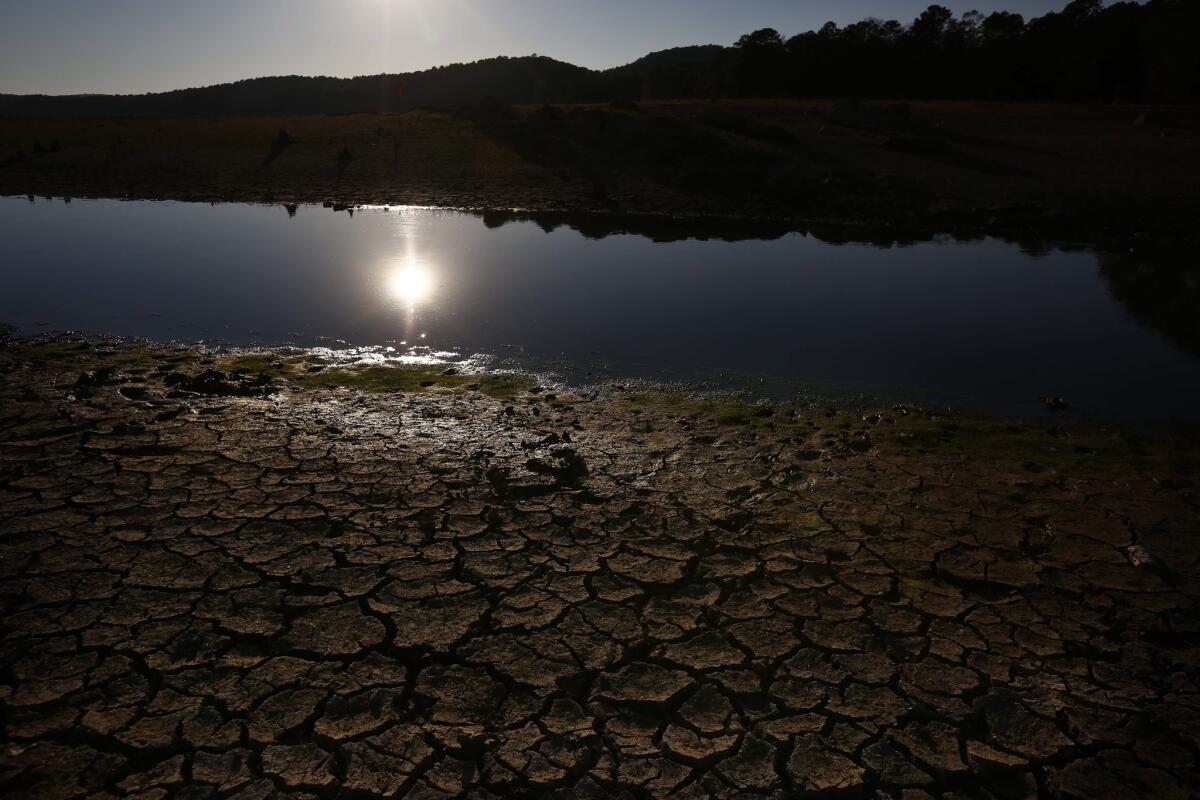It’s not just California. The Deep South is also reeling from a drought

An unusual haze, much thicker than traffic smog, hung over Atlanta on Wednesday.
It was smoke, blown in from wildfires in the mountains of northern Georgia, where hundreds of firefighters were battling blazes nourished by a severe drought gripping the nation’s Southeast.
How bad is the drought? “Anything that can set off a spark is a hazard,” said Sid King, a meteorologist at the National Weather Service’s office in Peachtree City, Ga.
The drought started months ago. With the region’s fall dry season now in full gear, there’s not likely to be much relief. On Thursday, the U.S. Drought Monitor will release its next report on the massive drought, which stretches from eastern Texas to the Carolinas.
The Southeastern drought almost challenges the longstanding Western drought, centered in California, as the largest in the nation.
As of late October, drought conditions rated severe or exceptional — the two worst categories — covered 73% of Alabama, 50% of Georgia, 16% of South Carolina and 12% of North Carolina, according to a report by the Southeast Regional Climate Center. Half of the stream gauges in Alabama and Georgia had recorded stream flows that were far below normal.
“This drought first developed back in the late spring, early May — and really, though, it really began to intensify during the summer,” said Jordan McLeod, a regional climatologist at the center, located in Chapel Hill, N.C.
The strength of the drought is the result of bad luck, if it could be called that. The rains that drenched Louisiana and led to disastrous floods this summer didn’t head east, and the tropical storms that flooded parts of the East Coast didn’t move west.
“Unfortunately those storms did not take a very favorable inland trek that would have brought some much-needed rainfall to interior areas that are under drought,” McLeod said of recent tropical storms that formed in the Atlantic Ocean and headed toward the U.S.
In Alabama and Georgia, which sit in the dry gap between the rainstorms, farmers are struggling to feed their cattle.
Ben Haynes, 38, is a fifth-generation farmer in Cullman County, Ala., who grows crops and raises cattle with his brother and his father.
This year’s corn yields have fallen to a third of what they’ve gotten accustomed to, while soybean yields dropped by half. Now, with the green grass drying up, the biggest problem is how to feed their cattle.
“Pasture conditions are as bad as we’ve ever seen,” Haynes said. “Our hay crop was about half the volume, and quality as well, of normal.”
Hay isn’t the only problem.
Some ponds created for watering livestock have dried up, forcing farmers to haul in water, said Jeff Helms, a spokesman for the Alabama Farmers Federation.
There are “quite a few places in Alabama that have had zero rainfall since August,” or maybe a couple months longer, Helms said.
Although the harvest season for spring-seeded crops has ended, he said, laying new seeds now means planting in soil that has little moisture and little promise.
Birmingham, Ala., was on track Wednesday to experience its 52nd consecutive day without any precipitation — which would tie the city’s longest streak on records going back to 1895. There’s no rain in the forecast for the near future.
“We could see potentially a 60-day streak there, almost two months essentially of no rainfall, but we’ll have to see how that plays out,” McLeod said.
Rains on Monday ended similar stretches in Mobile, Ala., which had gone a record 42 days without rain, and Pensacola, Fla., which had gone a record 41 days.
The drought has led to more than 1,000 wildfires across the Southeast since late summer, though those fires are typically smaller than those that churn through the wildlands of the West.
As of Wednesday, officials reported nearly a dozen large fires across Georgia, Kentucky, North Carolina and Tennessee.
Looking ahead to winter, climatologists don’t offer much hope. They expect the region to enter a weak La Niña phase, in which unusually cool Pacific Ocean waters cause dry conditions in the Southeast.
“It’s gonna be a long winter, and this is not an isolated deal,” Haynes said. “It has really expanded in the last two to three weeks, and there’s a lot of folks hurting. A lot of folks hurting.”
Twitter: @mattdpearce
ALSO
Clinton and Trump supporters come from different Americas. Between them lies bitterness and distrust
Bodies found on South Carolina man’s property were buried for a year
Can Trump fulfill his campaign promises on immigration and trade? Mexico hopes not
More to Read
Start your day right
Sign up for Essential California for news, features and recommendations from the L.A. Times and beyond in your inbox six days a week.
You may occasionally receive promotional content from the Los Angeles Times.







